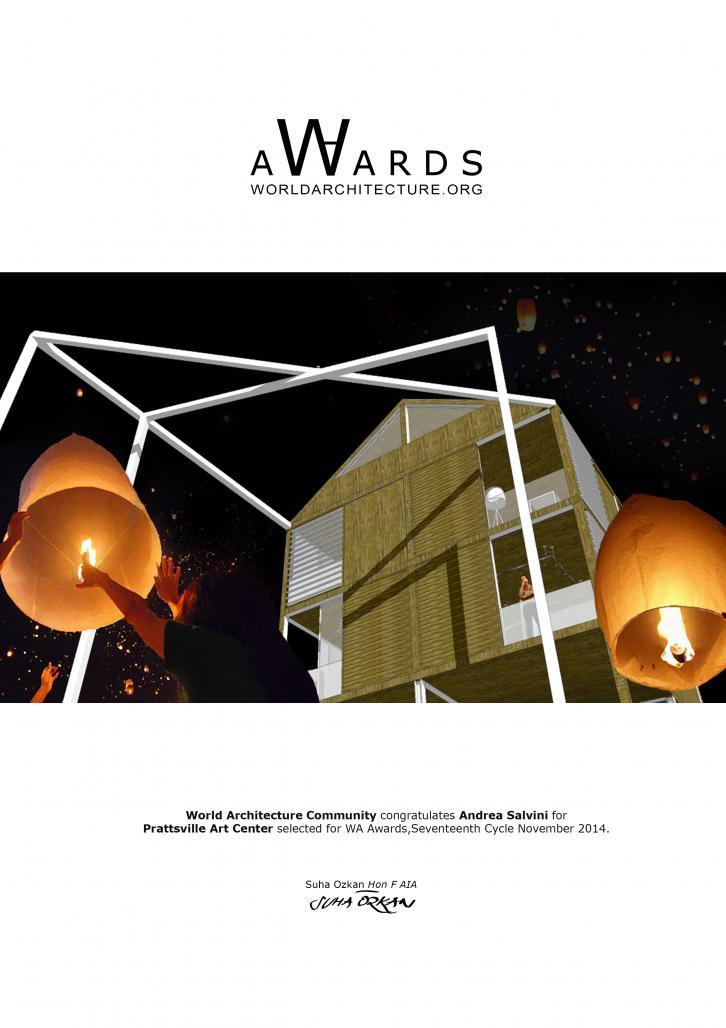The Prattsville Art Center will be the new cultural hub for the town of Prattsville, New York, and surrounding area, bringing together selected artists with residents of the historic Catskills town which was severely damaged by Hurricane Irene in 2011.
The project consists of restoring a 2,000 sq-ft historic building damaged by the flood in addition to building a new one housing artist residencies and workshops. The main focus of the new building is providing flexibility and usability for both interior and exterior spaces in order to host different activities in the center simultaneously. It also sets the goal to design a high-performance building for
energy efficiency and incorporate sustainable systems. Apart from its cultural mission, another goal of the center is to empower Prattsville to develop and implement recovery plans for future weather disasters.
Designed as a flood-resistant structure, another important role the building can play is serving as a public emergency shelter, aiding evacuations or simply as assembly spot for large groups of people, owing to its open plan. The new building will be a freestanding, three-story structure built in a revealing steel frame that accentuates its lightness and holds together all the other architectural elements made of wood and glass panels. A striking design feature will be its elevation from the ground on pilotis, or stilts, creating a ground-floor loggia in order to maximize the space of a very limited plot of land and meet the local building code and floodplain management regulations requiring new construction to be elevated from the ground. Slated to house interlocking art studios and a residency for visiting artists, the Center is designed to be a modern, live-work environment filled with natural light and an open, column-free interior for maximum flexibility where art and architecture complement each other. The studios are divided by floor-to-ceiling folding or sliding partitions, opening up the space in order to host exhibitions and events, which can serve community assemblies and meetings as well.
The façades are articulated by sliding wooden panels of a solar shading louver system which reveal -- when opened -- the glass skin of the building underneath. They also function to make the building as translucent or opaque to its surroundings, depending on the desired level of privacy. The shudders totally close and secure the building, protecting it from various weather conditions. Its like a showcase glass box filled with light while contained by a wooden skin that it alternately sheds or redresses itself according to the inhabitants needs. A large solarium on the rooftop level extends and maximizes the ground space for recreational outdoor activities. A major design feature of the roof will be its retractable window system, consisting of panels constructed to open and close by sliding within the roof. The operable roof pitch, sheltering the rooftop deck, is just one continuous line shaping the structure from the second floor up.
The creation of a courtyard between the old and new buildings is part of the plan for the center, acting as a piazza-inspired gathering point for recreational and cultural activities for the whole community. The piazza will include the striking, multifunctional architectural feature of a rotating steel frame connected to the new building within a triangular shaped light structure that can be used as a support for a film screen, as well art installations or banners. Staged performance events, such as dance or theater works, can utilize the frame as sort of sculptural, abstract proscenium. The paving of the square adjacent the building is divided into five, inclined triangular sections designed to integrate raised bed planters for vegetable and herb gardens. It can be occasionally covered with a lid surface to accommodate audience members during events or just for weather protection. It will also channel and collect rainwater in an underground water tank -- water which can serve the whole center and irrigate the garden.
The disaster-recovery nature of this initiative makes the project timely and relevant from both a design perspective as well as an environmental one, in a time when American institutions are still assessing how to identify a type of architecture that might respond to and prevent future disasters related to climate change. This initiative also raises another issue on how to reinvigorate an area affected by disaster on a socio-economic level. The art center is aimed at bringing energy and community to an economically depressed rural area, addressing various socioeconomic issues by offering programs designed to demonstrate the role art and architecture can play in the towns revitalization.
2013
Prattsville Art Center by Andrea Salvini in United States won the WA Award Cycle 17. Please find below the WA Award poster for this project.

Downloaded 83 times.









